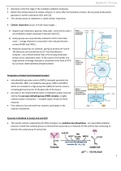Class notes
Biochemistry - TCA Cycle
- Course
- Bio 1000
- Institution
- University Of Manitoba (UManitoba )
Hi everyone ! These notes will definitely help you with Biochemistry. All the notes are precise and contain all the points you should know about these topics. So, you can use them as class notes, as well as summaries to get prepared well for your exams. Hope you guys will love these !
[Show more]



